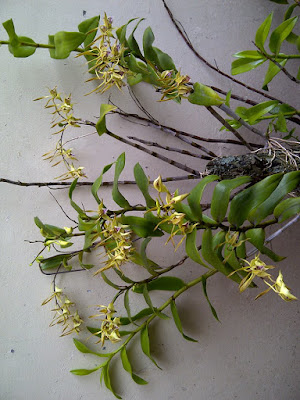Dendrobium bicaudatum is found in the Mollucas, Sulawesi and the Philippines. It grows on rocks from sea level to 1000 meters.
Dendrobium bicaudatum also called as The Two-Tailed Dendrobium, Callista bicaudata, Ceratobium bicaudatum, Ceratobium minax, Dendrobium antelope, Dendrobium burbidgei, Dendrobium demmenii, Dendrobium minax, Dendrobium rumphianum, is a species of the genus Dendrobium. This species was described by Caspar Georg Carl Reinwardt ex John Lindley in 1859.
IDENTIFY DENDROBIUM BICAUDATUM ORCHID PLANT
Dendrobium bicaudatum is found in the Mollucas, Sulawesi and the Philippines. It grows on rocks from sea level to 1000 meters.
It is a medium sized, hot to warm growing lithophyte with clustered, cane-like, narrowly fusiform, dilated at or below the middle, to 20 noded pseudobulbs carrying 4 to 10, thinly coriaceous, suberect, lanceolate to narrowly oblong-elliptic, unequally and obscurely sub-acutely bilobed apically leaves.
The Two-Tailed Dendrobium blooms mostly in the fall and winter on often 2 or more arising at a time, usually erect, axillary, 10 to 20 cm long, usually racemose, to 8 flowered inflorescence arising from the nodes near the apex of the pseudobulb. The flowers are yellow-green and last a long time. Lateral sepals 3/4 inch long, petals 1/2 inch long, with dorsal sepal and labellum about the same length. The petals have a line of fleshy warts from about the middle to the apex.
DENDROBIUM BICAUDATUM ORCHID PLANT CARE AND CULTURE
Cultural information should only be used as a guide, and should be to be adapted to suit you. Your physical location; where you grow your plants, how much time you have to devote to their care, and many other factors, will need to be taken into account. Only then can you decide on the cultural methods that best suit you and your plants.
Light:
Dendrobium bicaudatum like plenty of light, but cannot stand the full noonday rays of the sun (15000-40000 lux, filtered or diffused light is recommended.). These usually do best when placed so that they can get the early morning sun, but are shaded from about 10 a.m. onwards in the Summer time. In the Winter they can usually stand the sun's rays up to 11.30 a.m.
Temperature:
The average temperature of the summer day is 25-26 ° C, night 21 ° C, giving a daily difference of 4-6 ° C. In winter, the average day temperature is 27-30 ° C, night 16-17 ° C, giving a daily difference of 13 ° C.
Humidity:
The Two-Tailed Dendrobium need the humidity of 80-90% throughout the growing period (i.e. from the time the first shoots of Spring show themselves until the last pseudobulb in Summer has grown to its maximum). In winter, the humidity drops to 65%.
Too dry air has a negative effect on the development of the plant: its growth is inhibited, and the leaves begin to turn yellow and dry out. The higher temperature, the higher the humidity should be, and the higher the humidity, the more often and longer it is necessary to ventilate the room where the plants are contained, otherwise the probability of rotting and various kinds of fungal diseases.
Substrate, growing media and repotting:
Dendrobium bicaudatum grows best in wooden baskets with mixed compost of two parts of osmunda, two parts of peat or todea, and one part of good fresh sphagnum moss as substrate (line the bottom with a few large pieces of wood-charcoal, which helps to provide aeration, and counteracts any tendency of the compost to ferment). The pseudobulbs can be tied, where necessary, to the hanging wires, thus ensuring stability.
It does not need frequent repot, therefore, it is desirable to transplant only when it is really necessary, for example, in cases of strong salinization or compaction of the substrate, at its critically high or low pH (the norm is from 5.5 to 6.5) or when the plant grows very strongly and the pot becomes cramped to it (pseudobulbs begin to hang from the edges of the pot). Repotting is best done immediately after flowering when new roots and new growth begin to grow.
Watering:
The Two-Tailed Dendrobium water must be literally poured on throughout the summer season right up to the time when the season's growths have reached full development; with the coming of autumn the quantity of water should be appreciably diminished, but this plant should not be allowed to dry out, and even in midwinter watering should be continued by giving the compost a good soaking once a fortnight-choosing a bright, clear morning for the purpose.
Watering is directly dependent on the temperature of the content, the higher it is, the more often it needs to be watered. When watering, excess water should flow freely from the pot, since stagnation of water both inside the pot and in its pan can very quickly lead to rotting of the roots and the lower part of the plant.
Fertilizer:
It is recommended to use a 1/4-1/2 dose of orchid fertilizer weekly. You can use the balanced fertilizer throughout the year or from spring to mid-summer use high-nitrogen fertilizer, and then until the end of autumn high-phosphoric fertilizer to stimulate flowering.
Rest period:
Dendrobium bicaudatum need less water in the winter, especially if they grow under the conditions of a dark, short day that occurs at moderate latitudes. They should dry somewhat between waterings, but they should not be dry for a longer period. Frequent morning fogging and rare, economical watering should allow the plant to go through a dry period of rest, while providing it with sufficient humidity. Fertilization should be reduced or eliminated until new growths appear and a more abundant spring watering begins.















COMMENTS